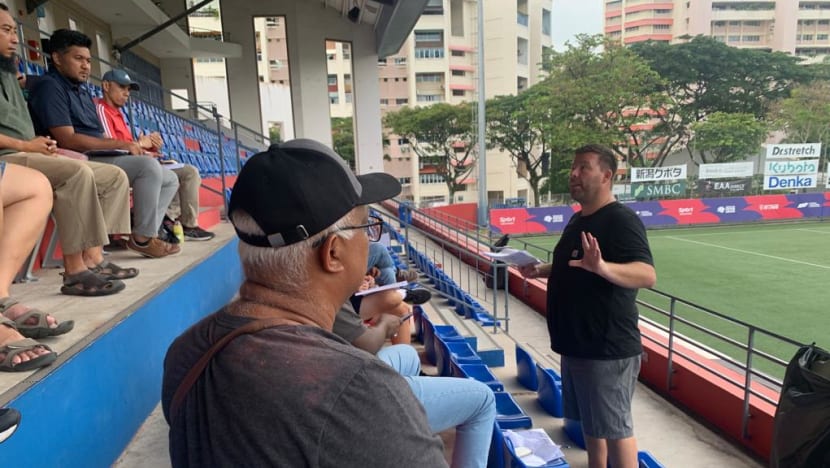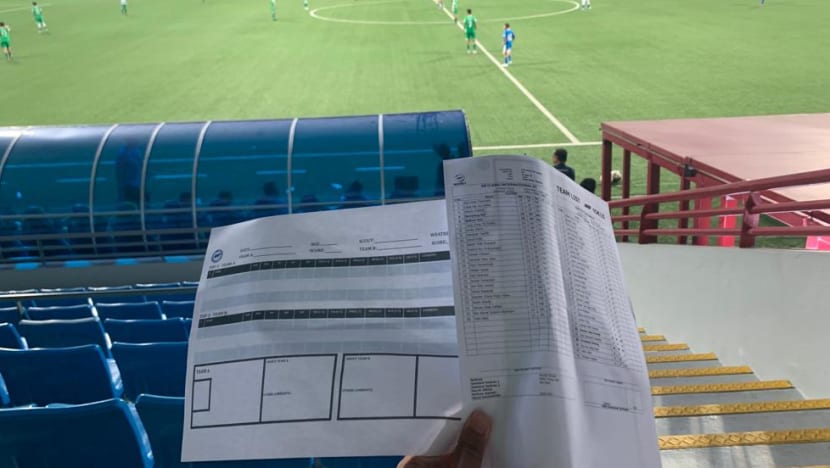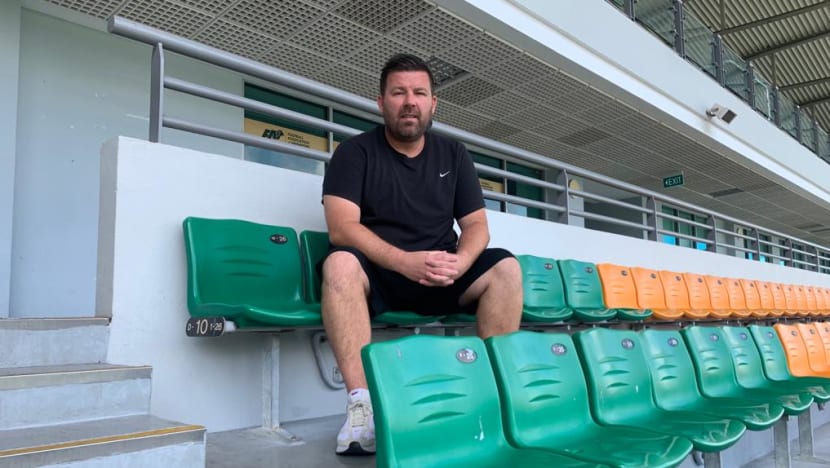How Singaporeans with 'a heart for football' are joining the search for the next generation of stars
CNA's Matthew Mohan attends a talent identification course to learn more about what being a football scout is like.

FAS' head of talent identification Kenneth Santa speaks to course attendees including CNA's Matthew Mohan. (Photo: CNA/Matthew Mohan)

This audio is generated by an AI tool.
SINGAPORE: The drums were thumping and the flags fluttering ahead of the match between clubs Geylang International and Lion City Sailors.
But for a moment, the fevered anticipation gave way to whispers of curiosity as a group of about 20, this reporter among them, trooped down one of the stands at Jalan Besar Stadium.
Who were these people and why were they armed with sheets of paper at an under-15 football game?
SCOUTING IS FOR ALL
Launched earlier in 2023, the Football Association of Singapore's talent identification course aims to give attendees basic insight and training for scouting gifted players at academy level.
It is led by FAS' head of talent identification Kenneth Santa, who hails from Denmark and previously held various scouting roles in the country.
He also worked in Asia at the Aspire Academy in Qatar, Punjab FC in India and a Saudi Arabian academy. He took up his role with FAS at the beginning of the year.
"Talent identification (ID) is an under-evaluated topic," he told CNA after the course. "I think that most football coaches have by themselves been doing talent ID and scouting, but not (in an) organised (way)."
What is unique about the course, he said, is that it's open to not only people with a coaching background. And one doesn't need to be a coach to be a good scout, Mr Santa explained.
"We wanted to make sure that everybody, no matter who they are, what background they have, could actually enrol."
And this was the case for my course, which ran from September to October and was the third one open to the public.
There were a total of 16 participants from different walks of life - not just within football. While some were interested in a career in football, others were simply passionate about the sport and wanted to contribute in their own way.
A total of four level 1 courses have been held since August this year, and demand has been through the roof, said Mr Santa. The first course was oversubscribed by three times. Courses in January and March next year are already fully booked.
The course is typically held over three sessions, each four hours long, and costs participants S$299.
By having a registration fee, participants show their interest in both learning and contributing, said Mr Santa.
"For me, it's not about whatever fee it is, but it's more about if you create an understanding before you meet, saying this is what we're going to deliver, this is what you can expect."
LEARNING BY DOING
Each session typically begins with theory before a practical scouting exercise.
We spent the first lesson discussing the difference between a player's performance and potential, as well as drawing up KPIs (key performance indicators) for a player in a position of our choice.
In the lessons which followed, we looked at topics such as creating a common footballing language via grading systems as well as guidelines for dealing with parents and coaches.
Hands-on participation is a key component of each session.
"We learn better by doing," said Mr Santa.
"You will always have people who are introverted and extroverted ... There will always be people who will want to watch more football, some would rather prefer the classroom discussion.
"(But) you cannot sit and hide behind the screen watching Manchester United beating Wolves and then hope that you're going to be qualified to watch young football players."

Over the three sessions, we watched matches between teams in the FAS' Centre of Excellence (COE) U-15 and U-17 youth leagues.
Sitting in the stands with a team sheet in hand, we were first tasked to focus on a particular player whom we had drawn up KPIs for, and to identify the top three players overall.
It was here, under the bright lights of the stadiums, when I realised just how difficult scouting is.
Mr Santa handed out scouting templates for us to fill in the positions of the players, as well as their preferred foot. Scouts do this early on in a game and this helps as they keep track of players, he explained.
As I squinted and desperately tried to decipher a Geylang International player's shirt number, time left me behind. We were already 20 minutes into the game.
Over the three sessions, this became easier, even though our tasks expanded as we got to grips with the process of scouting. This was helped by a usual halftime debrief, as well as post-game discussions.
IMPORTANCE OF ATTENDING GAMES
Throughout the course, Mr Santa stressed the importance of consistently attending games even after each session and after our time with him had ended.
"If you go and watch a U-15 game, then you get an understanding for that game. But if you haven't watched all the best players in the country in that age, how can you benchmark a player's level?" he said.
"If you're not going to go and watch games, then you shouldn't attend the course … But if you have an interest in football and you want to learn then definitely you should come because you will get tools which will be handcrafted from (my) experience from five, six different countries and of meeting up with different people and getting their inputs."
A number of my coursemates heeded that advice, going to games over the weekend and discussing players they saw in action.
It is this passion which Mr Santa appreciates and wants to utilise.
"I've learnt that we have a lot of people with a heart for football in Singapore," he said. "It's been overwhelming in terms of positive people."

The hope is for the talent identification course to educate "ambassadors" and contribute to building a network of scouts to supplement the various structures currently in place, said Mr Santa.
Some of these scouts could start out on a part-time basis, with full-time opportunities in future.
"Each of the people who go through the course, they have my phone number," Mr Santa added. "Now they have a direct line and if there (are) people to recommend ... they can.
"Hopefully our network of coaches and a network of spotters and network of people attending the course can put us in a position where less and less good players (fall through the cracks)."
For myself, while I might not be quitting my day job to become a football scout anytime soon, I'm definitely open to attending more youth games in the near future.
And if I do, I'm pretty sure I'll be seeing some of my coursemates there.

















